Some of you told us that you want an ISO version of the UHK so we've sent out a survey and received a whopping 1,372 responses over one week! Wow! It's truly exciting to see such an awesome, active community and let me just take the opportunity to thank every one of you for participating. We think that we learned quite a bit so let us share the questions, the responses, what we learned and the road ahead.
Your suggestions
There was a text box at the end of the survey where you could enter your suggestions so let's start by addressing the 10 most popular ones.
- Swap Control and Super for God's sake! - Fair enough. I intentionally diverged from the standard layout to make Control easier to reach but let's stick to the conventional layout then. It'll be updated on our site.
- I want to map Control or Esc to Caps Lock. - No problem, it's perfectly possible.
- I want blank keycaps - We'll provide a blank version.
- I'd like ortholinear / columnar layout. - I'm personally intrigued about columnar layouts and it can happen in the future but not anytime soon.
- A tilt stand would be nice for ergonomic purposes. - Indeed and we plan to make this a stretch goal of our campaign!
- I want a separate numeric pad. - We don't plan to offer any but you should be able to buy one from other manufacturers.
- Provide a Mac layout. - We will provide custom labels for Mac / Windows-specific keys.
- Please support Linux! - Given that our primary development platform is Linux we already support it.
- I need the AltGr key. - It's the same as the right Alt.
- What is this Super key? - Same as the Windows key.
The questions
It's important to note that question 2 and 3 were only visible to those who choose the ISO layout in question 1.
Question 1: Which layout do you prefer?
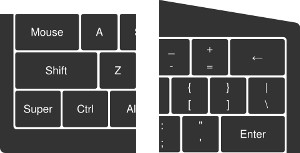
ANSI layout (featuring a bar shaped Enter key)
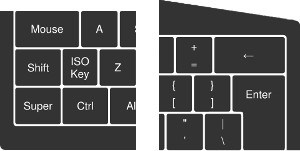
ISO layout (featuring an L shaped Enter key and an extra key next to the Left Shift key)
Question 2: Regarding the Enter key...
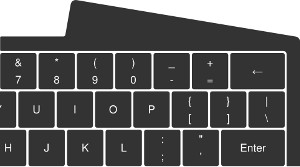
I'm fine with the ANSI Enter key despite being an ISO user.
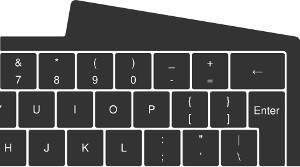
I'd prefer a small ISO Enter key.
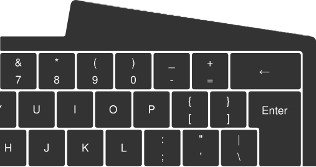
Only a full sized ISO Enter key works for me. (Please note that this would make the keyboard wider, more asymmetric and increase development time substantially.)
Question 3: Regarding the ISO key (the extra key next to the Left Shift key)...
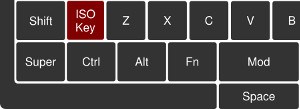
I don't need a dedicated ISO key. I'd rather map Mod+Z (or some other shortcut) to the ISO key.
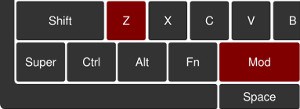
I need a dedicated ISO key.
The responses
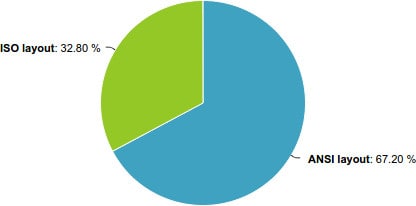
The above chart was filled out by all the 1,372 of the participants and the ISO-specific answers below were filled out by 450.
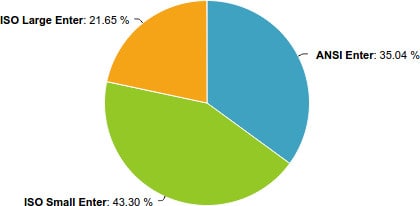
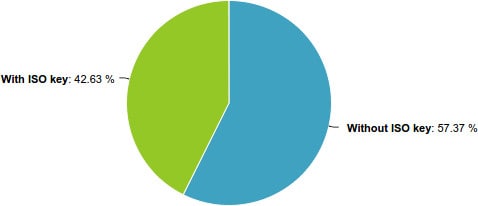
Why do people spare the ISO key so easily?
We expected those who choose the ISO layout to heavily insist to have a dedicated ISO key but oddly most of you choose the "Without ISO key" option. This clearly begs for some explanation so in order to gain a deeper understanding we looked into the keyboard layouts of various countries. As it turns out there are 3 main categories of country-specific ISO layouts regarding the ISO keys.
Relational ISO layouts
[fusion_builder_container hundred_percent="yes" overflow="visible"][fusion_builder_row][fusion_builder_column type="1_1" background_position="left top" background_color="" border_size="" border_color="" border_style="solid" spacing="yes" background_image="" background_repeat="no-repeat" padding="" margin_top="0px" margin_bottom="0px" class="" id="" animation_type="" animation_speed="0.3" animation_direction="left" hide_on_mobile="no" center_content="no" min_height="none"]
First up, it's important to realize that even though the above is the German layout, its ISO key yields the same characters as the Austrian, Croatian, Finnish, French, Greek, Italian, Latin American, Norwegian, Polish, Portuguese, Serbian, Spanish, Swedish and Turkish layouts so we're talking about a vast number of countries.
Let's name such layouts as "relational ISO layouts" because here the ISO key produces the < relational operator in itself, > when pressed along with Shift and | when pressed with AltGr. These are rather rarely used characters and in 2 of the 3 cases a modifier needs to be pressed to invoke them anyways so the ISO key doesn't seem to be that critical for this layout. One could easily map these characters to Mod+N, Mod+M and Mod+, respectively without significantly affecting productivity, according to the following mapping:
| UHK key combination | Scan code sent to the host | Resulting character |
|---|---|---|
| Mod + N | ISO key | < |
| Mod + M | Shift + ISO key | > |
| Mod + , | AltGr + ISO key | | |
Backslashed ISO layouts
[/fusion_builder_column][fusion_builder_column type="1_1" background_position="left top" background_color="" border_size="" border_color="" border_style="solid" spacing="yes" background_image="" background_repeat="no-repeat" padding="" margin_top="0px" margin_bottom="0px" class="" id="" animation_type="" animation_speed="0.3" animation_direction="left" hide_on_mobile="no" center_content="no" min_height="none"]
The above is the UK layout and its ISO key yields the same characters as the Irish, Romanian and Russian layouts. In the same vein, \ and | are rarely used characters and they can be similarly mapped to the Mod layer without really affecting productivity.
Special ISO layouts
[/fusion_builder_column][fusion_builder_column type="1_1" background_position="left top" background_color="" border_size="" border_color="" border_style="solid" spacing="yes" background_image="" background_repeat="no-repeat" padding="" margin_top="0px" margin_bottom="0px" class="" id="" animation_type="" animation_speed="0.3" animation_direction="left" hide_on_mobile="no" center_content="no" min_height="none"]
The above is the Hungarian layout and it's a special case because its ISO key yields letter Í which is part of the Hungarian alphabet. The Bulgarian layout is similarly special with its ISO key yielding letter Ѝ, part of the Bulgarian alphabet.
Even though the ISO key can be mapped to the Mod layer, in these situations this approach may be less comfortable given that we're talking about a letter of the native alphabet of these countries. In any case, these two countries only include 15 million people which is 0.2% of the population of Earth. (As a Hungarian I don't want to belittle these people, I'm merely talking about statistics.)
Summing up the ISO key issue
We think people have reevaluated the significance of the ISO key when presented with an alternative option, namely to map the ISO key to another layer. In light of this realization and according to the above the ISO key doesn't seem so critical. Some people won't be able to live without it but according to the statistics they're the minority of the ISO users.
You know what's the most surprising to us? We, as Hungarians thought that the ISO keys of all countries always feature a country specific letter but according to our research there are only 2 countries where this is the case. From our perspective this hardly justifies having an ISO key in most cases.
Do people need the ISO Enter key?
According to the statistics 64.95% of the participants who choose the ISO layout want an L shaped ISO key. It's very surprising for us because we thought that the ISO key is the main reason why people prefer the ISO layout but according to the above it's the L shaped Enter key. Also, we'd have thought that it's harder to get used to the Mod key than an alternative Enter key. How's that?
Final words
According to the above there's a need for ISO but it's not so big to justify making separate ANSI and ISO versions for a small startup like us. This doesn't mean that we won't ever release an ISO version but probably not for the first time.
We might have came to wrong conclusions here and there. As always, you're welcome to let your voice heard in the comments below.[/fusion_builder_column][/fusion_builder_row][/fusion_builder_container]
63 Responses
Looks brilliant; can't wait to see what you finalize and get my hands on one...
Thanks Kyle, we're working on it!
| \ is one of the most frequently used keys by anyone using a command line interface...
|and\are indeed often used in the command line but I think alphanumeric characters are more frequently used and it's easy to map these 2 characters via the Mod layer.Wait... are you saying that I would need to hit a key combo to use | and \ ... ? That seems crazy :)
Well, you already had to use a key combo for
|, namelyShift+\, so in this respect the situation was half-crazy anyways :)On the UHK you could invoke
\withMod+Nand|withMod+Mfor example.I agree with Matthew Coulson; I love the idea of this project, but the lack of an ISO layout (Specifically the \ | button on the UK keyboard) is a deal breaker, for now. Although they may be mappable, this just wouldn't be the solution for some of us.
Agreed - a dealbreaker for me too as I can't unlearn this muscle memory. I often pair on other people's keyboards. Just a mappable key between LShift and Z would do.
Yes, pretty much use | all day every day for command line. Use it a lot in coding too.
Does this mean you'll be pursuing an ANSI return key or a small ISO return key?
We'll be pursuing the ANSI Enter key.
Works for me! I'm really excited about this keyboard! Keep up the good work! =D
One size does not fit all, unfortunately. Them's that have passions have STRONG passions.
No doubt about it. We'd love to make everybody happy but it's just not practically possible. We're doing our best, though.
I am a coder and so used to have | type ISO key that it is second nature that is why i consider it is important. What comes to L shaped enter i guess it is the size and position that makes it that people are just so used to tap it "around there" with more larger "footprint". Atleast i remember typing always the keys above enter when i have used US layout type longer enter key and that shape also sugget more towards being right shift key. That is typically longer in ISO layout.
Thanks for the explanation, makes sense. I guess it's a question of whether someone wants to dedicate enough time to get used to an alternative layout. I know it's hard to break habits.
It's too bad people are so ISOlated in their responses, but I think that you have the right ANSIr... Answer.. Dammit, it's so close.
Most original comment of the blog ever, made my day! :D
Wouldn't a simpeler explanation be that at least some people didn't realise what the ISO key is? They maybe assumed it was some special function key, and only now realize that it is their < (or | or í) key?
Good point, but how could have we explained the ISO key any better? The title of the question is "Regarding the ISO key (the extra key next to the Left Shift key)". The graphics should also clarify things. Maybe we could have mentioned some example characters like the ones that you suggest. Thanks for the idea, we'll know better next time.
That's what I thought, as well. Perhaps many peole did not really realize, what they were voting for. Or they all only need the american standard layout. Either way, an extra key doesn't hurt anybody, does it?
The extra ISO key makes reaching the left Shift harder because it gets farther apart. It's a design tradeoff.
I just bought an HP computer that came bundled with an ISO keyboard. Used it for two days, then had to throw it in the bin and buy another keyboard. Typing passwords, with all the case changes and punctuation characters, was completely impossible because of fat-fingering that ISO key every time I went for the left shift, and going back to hunt-and-peck made logging on to anything a glacial exercise.
So yes, an extra key is about the worst thing a keyboard an have.
You are fat fingered and want as little keys as possible? seach no more, here is the keyboard for you: http://orbitouch.com/
This survey response is a little confusing with the other country keyboards listed and only small corners of the proposed keyboard shown. Can you add the final proposed layout so we can comment?
I also want / ? together and \ | together. Accessible with the right hand. Lastly, a tiny shift key on either side is a deal breaker.
You can see the proposed layout in the "The 4 Layers of the Factory Keymap" section of our main page.
/ ? and \ | are together.
Why do you insist to full sized shift keys? The right shift key is smaller than the standard by 0.5 unit, just like every key on the right side of the keyboard. People seldom press the rightmost centimeter of the right shift key, that's why I'm wondering.
I bought a popular mini keyboard a couple years ago that had a tiny right shift key. A K-400. The shift key was half size. That's what I mean by tiny. In its place was the up arrow of an inverted T. It was not functional and I threw it away.
Your layout on the main page looks good.
Thanks!
Just checked out the K-400. Now that's a miniature shift key. I wouldn't use that myself either.
My comments on your remarks regarding the German ISO layout:
* The German alphabet, just as many other languages as well, has more letters than the English. Therefore, the extra key is very welcome.
* As GNU/Linux users, you should know, that the characters mapped to that key: "" and "|" are one of the most commonly used in the shell and in programming. To claim that they are rarely used is flat out preposterous. Maybe you should figure out who you are targeting with your product. "The ultimate hacking keyboard" with open liscenses probably appeals to a lot of programmers and advanced GNU/linux users.
* I do not want to remap those keys to your suggestions, because those combinations are already taken in my conifg, since I use the keyboard excessively and already have shortcuts for lots of things. So I don't want to remap them at all.
* I am infatuated with your design and really would like to see this happen. However, losing that key unfortunately is a deal breaker to me.
Thanks for elaborating on these issues, Bjoern! Your reasoning makes sense although I believe the targeting of our product is right given that the audience welcomes the ANSI layout. We have to draw a line somewhere or else it'll take forever to make this project a reality. Once we manufacture and sell the ANSI version we'll give the ISO version another thought.
Fair enough. I guess I will be waiting, then. Good luck with your project. I hope you will succeed. It's awesome what you are doing!
All cards on the table. As a swede, also with additional characters, this will most likely be a deal breaker for me. I will think about it and try my handing, but I will most likely wait for an ISO version.
There is another argument for the ISO-Key. For German 'Hacker' Keyboard users there is the neo2 layout (http://neo-layout.org/) which uses the ISO-Key as one of themod keys. It makes no sense to remap this mod key to a combination of keys. Ignoring one key is a lot more easier then finding one that isn't there.
As programmer I am using the characters a lot and in an easy way.
Many thanks for your detailed concern... :-)
Like the Windows key, I still use keyboards without, I understand this. Maybe it is possible to create a design to make the change every time you want, like a bridged keycap and an layout setting with no mapping to the iso key
I think your bridged keycap idea is pretty ingenious and we haven't thought about it, so mad props for thinking outside the box. Unfortunately, it cannot be implemented because no space would be left for the keycap stabilizers of the Shift key.
Actually, your bridged approach may be possible given that we use the ISO key as the right keycap stabilizer of the full-sized ANSI left Shift! Let me discuss this with András.
The Enter key has one button between it and the ";" key, where the finger has to travel from to press the Enter key. With the ANSI Enter, despite it being larger, there is another whole key to travel across. Even when I write shell scripts (which uses | a lot), I use Enter many times more than | and \, so it makes sense for it to be closer. Plus, my finger knows where the \ and | belong now (above the Enter key), and changing that would be annoying.
I meant ISO Enter.
It didn't occur to me before but I personally like a num pad. It would be great if you could include a usb port or two on the right hand side keyboard so I could plug one in there. If we are going for wishlist items I would also like a headphone jack on the keyboard.
Unfortunately, we cannot integrate more USB ports simply because there isn't any extra space inside of the keyboard. Creating a compact keyboard is one of our leading principles.
To be honest, you are the first person who requested a headphone jack. :) I'm afraid this would add cost without providing extra usability for most people.
With regard to the "pipe" symbol ( | ), it is used in c++ and other programming languages, where it CAN be important if you are dealing with terniary logic.
Err... Seeing the full explanation of the ISO key I realize a misunderstood the question in the survey! Worse still: I probably gave the wrong answer! I wonder how many others may have done the same?
I believe that, in true hacker tradition, you cannot remove anything (previous functionality or key size) without upsetting people, while adding (more keys or bigger size) will generally not concern people excessively.
The layout of the keyboard is a major buying point as, along with the mouse, it's the input to the computer. Bring back the ISO key!!! ;)
Thanks for your work and best of luck with the project!!
Good conclusion, don't steal candy from a baby ;)
We're thinking about creating an ISO version eventually but it's hard enough to start up this project and more options would delay the process even more. Believe it or not some people really dislike the extra ISO key because it makes them harder to reach the left Shift, so this is a more complicated issue than one might think. Thanks for the best wishes, we try to make everybody happy on the long run. :)
Wouldn't the obvious solution be to have both the left shift key and the ISO key be programmed to be the left shift key? That way it's easy to reach and it can provide a separate button for people who depend on it.
Again, you're removing a key that many, myself included, depend upon.
What happens when you regularly hack on 3 keyboards as my own case? My own desktop keyboard is ok but I don't want to drag around one of these (marvelous) keyboards to use with my laptop or any other computer I need to use for an extended period!! Muscle memory works against using different keyboards in this fashion.
Good point! I guess this would be an acceptable compromise for many, althought some ANSI users would be frustrated for accidentally hitting between the ISO key and the left Shift.
As for the anti-ISO community, the obvious one there is to remap the iso as (an additional) left shift...? Does 1 key really make that much difference?
OOPS!! misunderstood the original email!!!!! NOT my day!!! XD
I use a mechanical brown cherry keyboard at the moment for gaming, it is not ISO but the keys have been reassigned before I got it so I can type as normal (live in Ireland, we use UK layout keyboards here) For a little while I lived in hope for an ISO keyboard from ultimate hacker but the layout you propose is a deal breaker for me. However I think your "survey" was just an advertising tool anyway I do not think you intended to give any attention to the outcome. You know what they say about statistics, "statistics never lie but ...... use statistics" please fill in the blank
If you take a moment to read this post then you can see in the Update 2 box at the top that finally decided to provide a half-ISO version featuring the ISO key in response to community feedback, so you simply cannot say that our survey was an advertising tool. We can gather subscribers so much easier than creating a survey and blog post like this and dealing with all the communication overhead, so it'd have been be a poor use of our resources if we created all of this merely for advertising purposes.
Good to see that the ISO key is on again. It would have been a deal breaker for me as well. Another note related to i18n worth taking into account, is the printed character on the keys. Not having the correct label on the keys may be a deal breaker for some as well.
Since most of your keys have some additional information printed on the side of the key, just swapping place of the keys is not an ideal solution. Also, there are those Dvorak-users out there, still going strong. Perhaps you could provide a chart of character stickers, for the end users to apply themselves?
We will use the most widely used labelling for the ISO key but we simply cannot satisfy everybody. Custom stickers may be viable, althought I'm afraid regarding their wear. We'll look into it, thanks for the idea!
There is yet another reason for the ISO key. There is a common technique used by those of use who use alternative layouts, such as Colemak.
By moving the keys on the bottom row (Z X C V B) one space to the left, it enables a more symmetrical and comfortable finger technique. Qwerty uses could do this also, but it makes particular sense for optimized layouts.
http://colemakmods.github.io/mod-dh/gfx/angle_mod.png
I would not consider purchasing any keyboard that did not have the ISO key, as for me, Z is located there!
Thanks for the extra insight, Steve, very interesting stuff! Just another reason why providing ISO was a good choice.
As programmer I prefer ANSI (as I have not to hit 2 keys to have ; so common in programming nor alt+121 / alt+126 for {} or going on internet/charmap searching tilde for ~), but I also can't go without the «ALT GR» key (which let mi write áéíóú in one step and also because writing something like com'è would require me to hit `+[blank]+`+e instead of `+[blank]+[altgr e], while on my native italian layout (without dead keys) it has '+è keys.
It just makes problem when looking for ° § or ç quite often used in my passwords and that I cannot find as easly on ANSI nor the € that (at least on linux) isn't present and on ISO can be written hitting alt-gr+E
Thanks for your input! Actually, AltGr is the same as right Alt, it's just not labelled as such.
Found this by chance on my research for layouts and I must say, ihis is a great read even 3 years later and to someone who has no link to any of the products here (so far). If this ever gets rebooted or maybe rewritten into a guide/overview, please add to the pool of layouts the Brazilian ABNT. It's an ISO variation very similar to the Backslashed ISO layout, with the symbols switched around a bit, and an added "Ç" key, but most importantly: instead of a huge Left Shit, there's an extra key, where we map "/ ?" so it's opposite to the "\ |" key besides the right shift. This gets rid of the modifier hardship of using the ISO key as analyzed and give an extra key in a very useful place.
I was very surprised when I first learned other ISO layouts had such a huge left shift instead of making use of that very valuable space. The Brazilian ABNT is definitely a good candidate for a universal physical layout, where everyone maps their keys as desired. I don't think I can ever part ways with it.
http://s2.glbimg.com/hlQMZ_E87B3DB_96rVuO_pY2Yy8=/695x0/s.glbimg.com/po/tt2/f/original/2016/06/21/900px-kb_portuguese_brazilsvg_.png
You love to see the ortho linear version. I do currently use UHK but of late I see my colleagues using ortho linear key boards. Seem to improve the speed.
Thanks for the idea! We plan to make a columnar UHK eventually.
Is there a release schedule for the columnar UHK yet?
It's on our roadmap, but it's not public. We'll announce it when the time comes.